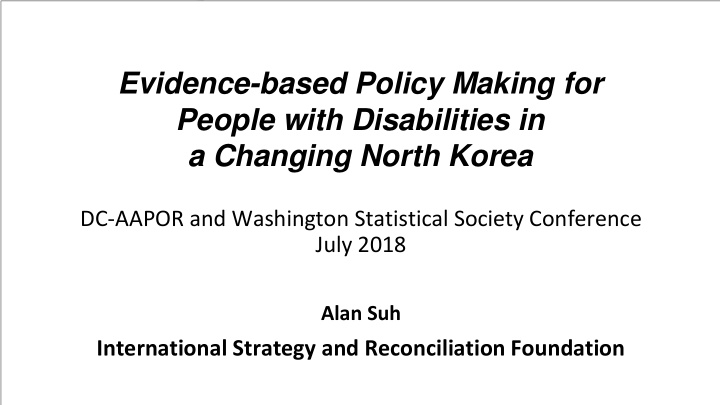



Evidence-based Policy Making for People with Disabilities in a Changing North Korea DC-AAPOR and Washington Statistical Society Conference July 2018 Alan Suh International Strategy and Reconciliation Foundation 1
“ Acknowledgement of Co-Authors Allison Conners, University of Toronto Helene Cho, University of Pennsylvania Paul Chun, ISR Foundation Alan Suh, ISR Foundation Asaph Young Chun, U.S. Census Bureau *All co-authors are affiliated with the ISR Foundation Center for Science Diplomacy. 2
“ Outline ● Introduction and Literature Review ● Research Questions ● Methodology ● Data Visualization-Based Analysis and Findings ● Conclusions 3
Convention on the Rights of Persons with Convention on the Rights of “ Disabilities Persons with Disabilities “This invitation and the recent ratification of the CRPD, whereby the authorities will have to progressively implement its provisions, are a positive indication of the promotion and protection of the rights of persons with disabilities in the country .” Catalina Devandas-Aguilar, United Nations 4
Introduction “ - International Strategy and Reconciliation Foundation (ISR Foundation) conducts research on evidence-based policy making - Why North Korea? 5
“ North Korea Population Structure 6
Key Literature on Disabilities in “ North Korea - People with Disabilities in a Changing North Korea (Katharina Zellweger) - End of Mission Statement by the United Nations Special Rapporteur on the rights of persons with disabilities (Ms. Catalina Devandas-Aguilar, United Nations) 7
“ Research Questions - Are there certain segments of the North Korean population that are disproportionately affected by disabilities? - Prevalence of people with disabilities - Person-level Correlates (e.g., Age and gender) - Environmental Correlates (e.g. Rural vs. Urban) - How do prevalence and incidence of disabilities in the DPRK compare internationally? 8
“ Methodology - Using 2008 North Korean census and 2012 Nutrition Survey - Inform public policy officials to the best of our ability - Team Science and Data Visualizations 9
“ DPRK Census Question on Disabilities Using 2008 North Korean census and 2012 - Nutritional Survey Inform public policy officials to the best of our - ability 10
“ Limitations - Cultural Barriers - Social Stigma with Disabilities - Lack of Data 11
North Korean People with “ Disabilities by Level of Severity 12
“ North Korean People with Disabilities by Gender 13
“ 14
North “ Korean People by Disability Type and Age 15
“ 16
North Korean People by Disability “ D Type, Age, and by Distribution 17
Malnutrition in North Korea and Its “ Relevance to Disabilities Key findings from the 2012 Nutritional Survey and the implications for North Korea’s disabled people 18
“ Prevalence of Chronic Malnutrition by age Prevalence of Chronic Malnutrition by age 19
“ 20
“ Conclusion -Implications for policy makers -Future Research -Use of DVs 21
“ Cited Works Linhorst, Molly. (2014). Visualizing the "Hermit Kingdom" Graphing, Mapping, and Analyzing the 2008 North Korean Census. Syracuse University Honors Program Capstone Projects. Retrieved from https://surface.syr.edu/honors_capstone/809 Campbell, Anne, and Uren, Marie. (2011). 'The Invisibles'... Disability in China in the 21st Century. International Journal of Special Education, 26 (1), 12-24. Retrieved from Murray, C., C. J., and Lopez, Alan. (1994). Quantifying disability: data, http://files.eric.ed.gov/fulltext/EJ921178.pdf methods and results. Bulletin of the World Health Organization, 72(3) 481. Retrieved from Central Bureau of Statistics. (2009). DPR Korea Population Census National Report. Retrieved https://www.ncbi.nlm.nih.gov/pmc/articles/PMC2486704/pdf/bullwho00414- from https://unstats.un.org/unsd/demographic/sources/census/wphc/North_Korea/Final%20na 0157.pdf tional%20census%20report.pdf Murray, D., Christopher J L et al. (2012). Disability-adjusted life years Central Bureau of Statistics. (March 2013). DPRK Final Report of the National Nutrition Survey (DALYs) for 2012. Retrieved from 291 Diseases and injuries in 21 regions, 1990 – 2010: a systematic analysis https://www.unicef.org/eapro/DPRK_National_Nutrition_Survey_2012.pdf for the Global Burden of Disease Study 2010. The Lancet, Volume 380, Issue 9859, p. 2197 Fujiura, Glenn T. and Hye J. Park, Violet Rutkowski ‐ Kmitta. (November 2005). Disability - 2223. Retrieved from http://www.thelancet.com/journals/lancet/article/PIIS0140- Statistics in the Developing World: A Reflection on the Meanings in our Numbers. Journal of 6736(12)61689- Applied Research in Intellectual Disabilities Volume 18, Issue 4. 4/fulltext Retrieved from https://doi-org.libproxy.mtroyal.ca/10.1111/j.1468-3148.2005.00268.x Zellweger, Katharina. (2014). People with Disabilities in a Changing North Kim, Shin Jeong and Kang, Kyung Ah. (June 2003). Meaning of life for adolescents with a Korea. Shorenstein physical disability in Korea. Journal of Advanced Nursing , Volume 43, Issue 2. Retrieved APARC Working Papers, Stanford University. Retrieved from from https://doi-org.libproxy.mtroyal.ca/10.1046/j.1365-2648.2003.02689_1.x 22 http://aparc.fsi.stanford.edu/sites/default/files/Zellweger_Disabilities_DPRK_w eb.pdf
“ Thank you Alan Suh alansuh918@gmail.com International Strategy and Reconciliation Foundation http://www.isr2020.org/ 23
Recommend
More recommend